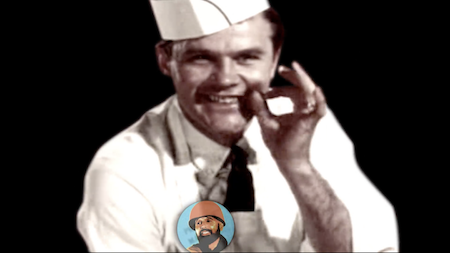by Jarrett Hoffman

The conservatory’s New Music Ensemble, directed by Keith Fitch, will celebrate the 100th birthday of that classic work with the premiere of a new film: a commission from Cleveland-based video artist Kasumi, to be played simultaneously with the music. (The concert is free, and will also be live-streamed.)
And if you’re at all familiar with the work of Kasumi, you know you’re in for a fascinating, perhaps harrowing ride.
The trailer gives a taste of her style, in which she splices together images from mid-century B-movies, commercials, and training films from the public domain — images which are “completely direct,” as Kasumi told us during an interview last year. “The acting is so bad and corny that it conveys emotion in shorthand — it becomes a symbol, like a stop sign. If you weave together these tiny gestures, you get all kinds of nuances of emotion.”
Of course, Kasumi and Fitch knew that the soldier selling his fiddle to the devil would play an important role in the video. “I wanted to parallel this Faustian bargain we’re witnessing in real time, which is today’s politics,” Kasumi said during another interview last week.
She noted another parallel: the “chaos, terror, and isolationism” of the period around World War I — another centennial this year. “Soldier’s Tale isn’t so much a protest piece as it is a cautionary tale, a coming-of-age story for the apocalypse,” she added.
The devil and soldier are both played by dancer Martín Céspedes in footage shot by Kasumi. “Oh my god, he is such a great devil,” she said. Some small roles, like the old woman and the peddler, are cut from this version of the piece. The filmmaker explained that they’re part of the Russian folk theater tradition, which was important to writer C. F. Ramuz for the original text. Her “raw materials,” as she put it, are different.
The project is actually Kasumi’s second foray into Soldier’s Tale — the first was a collaboration with the New York Philharmonic in 2005 which included several other components: narration, puppetry, and acting. The CIM performance boils it all down to Stravinsky’s music and Kasumi’s newly created visual narrative.
“This was a totally fresh start,” she said. “The advantage is that I already knew the music really well, and now I really know it — oh my goodness, I worked on the film for five months.”
When we spoke, Kasumi had just heard the first rehearsal with musicians together with the film. “It went really well,” she said. “They are so good — great conductor, great players. I’m excited.”
That conductor is CIM student Dean Buck. In an article on the conservatory’s website, Fitch noted Buck’s prior experience conducting the entire piece, which is known for its challenge to players and maestro alike. “He’ll wear headphones, and before each movement there are clicks to indicate the tempo. The thing about Stravinsky’s music is there’s very little rubato, so everything works out as long as the tempo is kept.”
How were those tempi chosen? “We found a recording that we really liked, where the tempi were correct — they were Stravinsky’s tempi,” Fitch said.
With Kasumi as guest artist for the evening and Soldier’s Tale as the centerpiece, everything clicked for Fitch to pair the work with Esa-Pekka Salonen’s Catch and Release. Not only does it have the same instrumentation as L’Histoire — it was written as a companion to that work — but it also features a visual accompaniment by Kasumi: her 2010 Quadrascope.
“It’s a totally different work,” Kasumi said of Quadrascope. “It’s much more abstract. With Catch and Release, there’s a mathematical playfulness, an intensity, and a hyper-layered quality, and this film reflects that.”
Rounding out the program is Stravinsky’s 1914 Three Pieces for String Quartet. “To open up the program, I wanted something else by Stravinsky for continuity,” Fitch said. The Three Pieces “set up the world we’re living in with L’Histoire really well, and they’re pieces that often get studied but people don’t hear them live.”
On Thursday, October 25 at 4:30 pm in Mixon Hall, Kasumi will discuss her work during the free and open-to-the-public New Music Symposium.
Published on ClevelandClassical.com October 22, 2018.
Click here for a printable copy of this article






